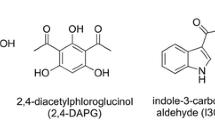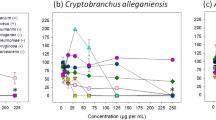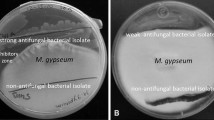Abstract
Beneficial bacteria that live on salamander skins have the ability to inhibit pathogenic fungi. Our study aimed to identify the specific chemical agent(s) of this process and asked if any of the antifungal compounds known to operate in analogous plant–bacteria–fungi systems were present. Crude extracts of bacteria isolated from salamander skin were exposed to HPLC, UV-Vis, GC-MS, and HR-MS analyses. These investigations show that 2,4-diacetylphloroglucinol is produced by the bacteria isolate Lysobacter gummosus (AB161361), which was found on the red-backed salamander, Plethodon cinereus. Furthermore, exposure of the amphibian fungal pathogen, Batrachochytrium dendrobatidis (isolate JEL 215), to different concentrations of 2,4-diacetylphloroglucinol resulted in an IC50 value of 8.73 μM, comparable to crude extract concentrations. This study is the first to show that an epibiotic bacterium on an amphibian species produces a chemical that inhibits pathogenic fungi.




Similar content being viewed by others
References
Brodhagen, M., Henkels, M. D., and Loper, J. E. 2004. Positive autoregulation and signaling properties of pyoluteorin, an antibiotic produced by the biological control organism Pseudomonas fluorescens Pf-5. Appl. Environ. Microbiol. 70:1758–1766.
Currie, C. R., Poulsen, M., Mendenhall, J., Boomsma, J. J., and Billen, J. 2006. Coevolved crypts and exocrine glands support mutualistic bacteria in fungus-growing ants. Science 311:81–83.
Harris, R. N., James, T. Y., Lauer, A., Simon, M. A., and Patel, A. 2006. The amphibian pathogen Batrachochytrium dendrobatidis is inhibited by the cutaneous bacteria of amphibian species. EcoHealth 3:53–56.
Lauer, A., Simon, M. A., Banning, J. L., André, E., Duncan, K., and Harris, R. N. 2007. Common cutaneous bacteria from the eastern red-backed salamander can inhibit pathogenic fungi. Copeia. 2007:630–640.
Ligon, J. M., Hill, D. S., Hammer, P. E., Torkewitz, N. R., Hofmann, D., Kempf, H. J., and van PEE, K. H. 2000. Natural products with antifungal activity from Pseudomonas biocontrol bacteria. Pest Manage. Sci. 56:688–695.
Raaijmakers, J. M., Vlami, M., and de Souzal, J. T. 2002. Antibiotic production by bacterial biocontrol agents. Antonie van Leeuwenhoek 81:537–547.
Rao, K. V., and Reddy, G. C. 1990. Synthesis and herbicidal activity of the halo analogues of pyoluteorin. J. Agric. Food Chem. 38:1260–1263.
Rollins-Smith, L. A., Reinert, L. K., O’Leary, C. J., Houston, L. E., and Woodhams, D. C. 2005. Antimicrobial peptide defense in amphibian skin. Integrative and Comparative Biology 45:137–142.
Sako, M., Kihara, T., Okada, K., Ohtani, Y., and Kawamoto, H. 2001. Reductive cleavage of heteroaryl C-halogen bonds by iodotrimethylsilane: facile and regioselective dechlorination of antibiotic pyrrolnitrin. J. Org. Chem. 66:3610–3612.
Simmaco, M., Mignogna, G., and Barra, D. 1998. Antimicrobial peptides from amphiban skin: what do they tell us? Biopolymers (Peptide Science) 47:435–450.
Timms-Wilson, T. M., Kilshaw, K., and Bailey, M. J. 2005. Risk assessment for engineered bacteria used in biocontrol of fungal disease in agricultural crops. Plant Soil 266:57–67.
Walters, R. L. 2007. Antibiotic production by cutaneous bacteria isolated from two species of salamanders. MSc thesis. James Madison University, Harrisonburg.
Whistler, C. A., Corbell, N. A., Sarniguet, A., Ream, W., and Loper, J. E. 1998. The two-component regulators GacS and GacA influence accumulation of the stationary-phase sigma factor sigma σs and the stress response in Pseudomonas fluorescens Pf-5. J. Bacteriol. 180:6635–6641.
Author information
Authors and Affiliations
Corresponding author
Rights and permissions
About this article
Cite this article
Brucker, R.M., Baylor, C.M., Walters, R.L. et al. The Identification of 2,4-diacetylphloroglucinol as an Antifungal Metabolite Produced by Cutaneous Bacteria of the Salamander Plethodon cinereus . J Chem Ecol 34, 39–43 (2008). https://doi.org/10.1007/s10886-007-9352-8
Received:
Revised:
Accepted:
Published:
Issue Date:
DOI: https://doi.org/10.1007/s10886-007-9352-8




